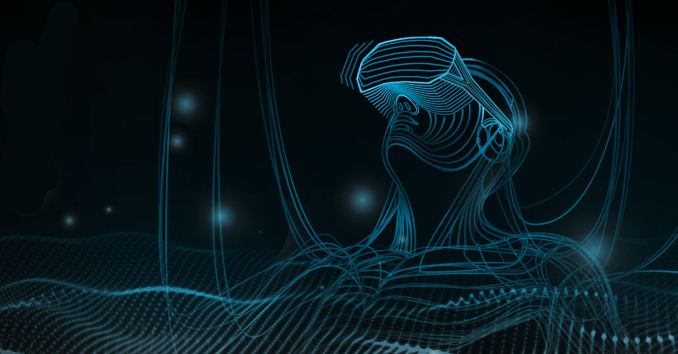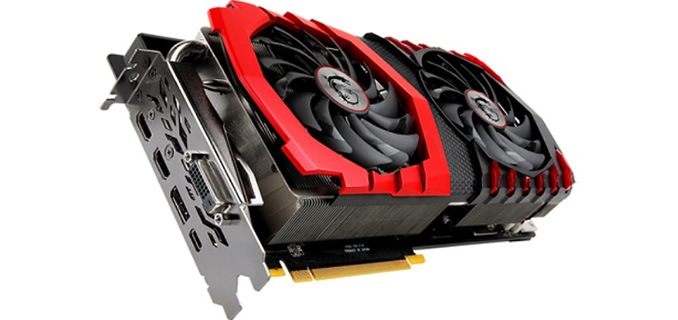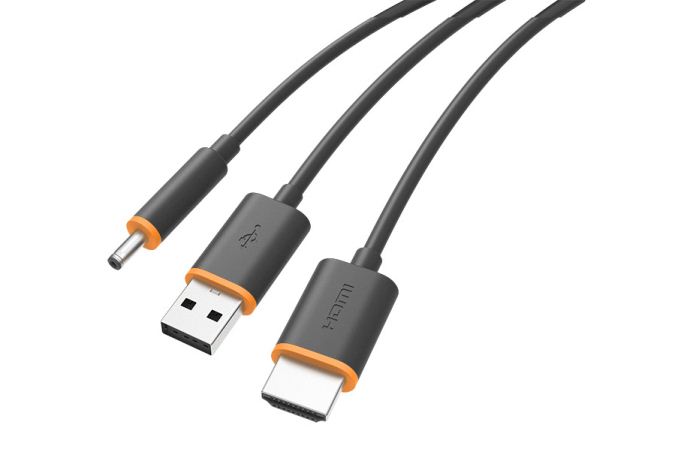VirtualLink USB-C Alt Mode Announced: Standardized Connector for VR Headsets
by Ryan Smith on July 17, 2018 9:30 AM EST
While PC VR headsets are fun, no one has especially enjoyed the number of cables required to hook one up. With separate video, power, and data cables, the end result has been that manufacturers have used somewhat unwieldy cables or breakout boxes. However as part of the generalized push towards the second generation of VR headsets, a new industry consortium is coming together today to reduce the requirements to a single cable. Backed by NVIDIA, AMD, Oculus, Valve, and Microsoft, the new VirtualLink standard is a USB Type-C alternate mode that will be able to supply all of the necessary power, video information, and data over a single Type-C cable and connector.
Today’s announcement from the group is essentially a call for participation, announcing the group’s existence and inviting others to get involved ahead of the VirtualLink 1.0 specification. So the consortium and its members are broadly talking about the standard itself, but are not saying anything about products that may implement it. And indeed as of Monday evening as I’m writing up this article, the VirtualLink consortium’s website still isn’t up.
In any case, the rationale for creating a standardized connector is pretty straightforward. A clunky multi-port cable is okay for first-generation early adopter products, but if the consortium members want to push VR adoption, then the setup process needs to be easier to reach the masses. This includes not only reducing the cable down to a single port, but also making these headsets easier to use with laptops, where HDMI ports are uncommon and DisplayPort is primarily picking up penetration through the popularity of the associated USB-C alternate mode. So a standard for a single cable, using the smallest yet most compatible port choice, is going to be the best way forward.
What this amounts to is that the standard is being implemented as a USB Type-C alternate mode. USB-C is the natural choice here, as the wider industry is already consolidating around the port for external connectivity, and the port + cable is designed to carry multiple lanes of data along with significant amounts of power. In fact I was a bit surprised that this required a new alternate mode at all – we already have the DisplayPort alternate mode – but after checking with the consortium, there is a good reason for this.
The official VirtualLink standard calls for 6 lanes of high speed data – 4 DisplayPort HBR 3 channels for video, and a single USB 3.1 Gen 2 channel (2 lanes) for data – along with a mandatory 15W of power. And while you can combine the DisplayPort alt mode with those power requirements, the lynchpin is 4 lanes of video plus the USB 3.1 Gen 2 data channel. By the standard, DisplayPort alt mode replaces all of the USB 3.1 data channels when using a full 4 lane configuration, leaving only the much slower USB 2.0 baseline channels available.
| USB Type-C Alternate Modes | ||||||
| VirtualLink | DisplayPort (4 Lanes) |
DisplayPort (2 Lanes) |
Base USB-C | |||
| Video Bandwidth (Raw) | 32.4Gbps | 32.4Gbps | 16.2Gbps | N/A | ||
| USB 3.x Data Bandwidth | 10Gbps | N/A | 10Gbps | 10Gbps + 10Gbps | ||
| High Speed Lane Pairs | 6 | 4 | ||||
| Max Power | Mandatory: 15W Optional: 27W |
Optional: Up To 100W | ||||
As it turns out, tucked away in version 1.3 of the USB Type-C cable specification released last year, the USB-IF has made some small but important changes to what alternate modes are allowed to do, which in turn means that new standards are needed to take advantage of these changes. In short, for direct connect devices – that is, devices connected directly to a USB-C port and not going through a hub or other extender/repeater – those devices are now allowed to reconfigure the 4 USB 2.0 pins (A6/A7/B6/B7) after the device handshake. So for the VirtualLink standard, this means that VR headsets can tap these additional 4 pins, giving them the extra flexibility they need in order to simultaneously meet the video, power, and data requirements of a VR headset.

VirtualLink Receptacle Pin Configuration (Color Coded)
Diving a bit deeper, what this essentially means is that the 4 USB 2.0 pins have been turned into another pair of high-speed differential lanes, giving compliant USB-C connectors 6 high-speed lanes overall. Normally these 4 pins are implemented in a USB-C cable as simple unshielded twisted pairs, which is sufficient for USB 2.0 data. However high-speed operation requires shielded differential pairs, which is not part of the base cable specification. But in the case of direct connect devices, they come with their own cable, meaning the usual cable rules can be thrown out the window and vendors can specifically use higher quality cabling to get away with high speed data on these pins.
The net result of all of this is that the VirtualLink standard is a rather forward-looking standard in terms of capabilities. 4 lanes of HBR3 video data alone is equivalent to a DisplayPort 1.4 connector, which is to say that it offers enough video bandwidth for 4K @ 120Hz with 8bpc color. This is more than double the bandwidth afforded to the Rift and Vive via their HDMI 1.3 connectors. I also find it interesting that after favoring HDMI for the first-generation products, this change means the industry is shifting to DisplayPort. DisplayPort of course is royalty free, among its other advantages, however its packet-based data transfer paradigm is very different than HDMI’s classic pixel-based TMDS system, which is an important distinction when you’re talking about how to best fight latency.
Meanwhile a full USB 3.1 Gen 2 data connection means there’s 10Gbps of bandwidth for data transfers between HMDs and the host computer, which right now at least is bordering on overkill. Though I’m very curious what the consortium is doing here (if they’re doing anything at all) to combat the fact that USB 3.1 Gen 2 data is normally only rated to run over 1 meter cables due to faster signal attenuation, which is a rather short cable length for a VR headset and the room scale experiences the vendors are pushing. Otherwise the power standard is a bit more complex; the standard supports up to 27W of power, but only 15W of that is mandatory. Of course the current Vive and Rift consume a fraction of that, but they had to be designed around the limitations of a USB 3.0 Type-A connector to begin with. As headsets become increasingly powerful in their own right – especially with inside-out tracking – a greater power budget will undoubtedly come in handy. (As an aside, the consortium’s announcement doesn’t list voltages here, but 15W & 27W are almost certainly 5V & 9V @ 3A respectively, a common mid-power point for USB-C devices.)
Unfortunately this is the limit to what we know about the specification at this time. As mentioned previously, the consortium’s members aren’t talking about specific implementations quite yet, such as which types of devices the members would like to put VirtualLink-capable USB-C ports on. For desktop PCs the logical choice is video cards – especially if USB-C eventually replaces the DisplayPort connector outright – which is something we’ve seen manufacturers toy with, but not actually reach shipping products. This would also be consistent with the consortium’s goals of making VirtualLink a low-latency port (owing to the comfort requirements for VR).

MSI's Unreleased USB-C Equipped GTX 1080 Ti
The flip side to all of this is that AMD, NVIDIA, and their board partners would need to start implementing either USB 3.1 controllers or USB 3.1 headers on their cards, in order to supply the necessary data connectivity. Which is not too difficult to do, but it’s yet another feature that video cards would need to support. And without going too far down the rabbit hole here, where this ultimately could lead to is that we’re about to see a major shift in the kinds of ports available on video cards, especially if most video cards need to be VirtualLink capable to maximize the number of systems that can be used with VR headsets.
Conversely, laptops should be relatively easy due to their highly integrated nature. USB-C ports are already common there, so it’s just a matter of adding another USB-C alternate mode. However it does call into question whether the consortium will be able to convince laptop manufacturers to adopt the alt mode for large swaths of their product lines (similar to the DP alt mode today), or if it will only be found on high-end gamer-focused laptops.
In any case, this should be a welcome development for the industry as a whole. While VR hasn’t proven to be as immensely popular with consumers as some vendors had hoped, VR headset adoption has shown solid growth and spurred plenty of system upgrades to drive the data-hungry headsets. So anything that further simplifies the process is going to be a welcome move for consumers and hardware vendors alike.
Source: VirtualLink












50 Comments
View All Comments
PeterThorpe81 - Wednesday, July 18, 2018 - link
I'm not really seeing much point in this over USB-C DisplayPort with Power Delivery it seems relatively minor. DisplayPort already has a 720Mbps aux channel which could be used for tracking, sensors, audio and other data. Are these devices really going to use more than that? Or am I missing something? Is seems to me the mistake was going with HDMI.The next version of DisplayPort is meant to double the bandwidth, they could well use the extra pins completely differently making more "standards".
Also in the article it says DisplayPort 1.4 will be 4k at 120Hz 8bit colour. If they use Display Stream Compression which is part of the standard it can be pushed a little higher to support 10 bit with HDR or a slight framerate boost.
edzieba - Wednesday, July 18, 2018 - link
As well as the extra USB 3.1 bandwidth (and avoiding eating into DP link bandwidth, which is what the Aux Channel does), VirtualLink also formalises other things like link negotiation, and cable standards. e.g."Though I’m very curious what the consortium is doing here (if they’re doing anything at all) to combat the fact that USB 3.1 Gen 2 data is normally only rated to run over 1 meter cables due to faster signal attenuation, which is a rather short cable length for a VR headset and the room scale experiences the vendors are pushing."
The spec demands that both the DP channels and both USB 3.1 directions all conform to the same minimum signal characteristics e.g. dB budget (demonstrated in the spec with a 5m cable but could be longer depending on component selection).
DSC can be ruled out (too high latency for VR), but Multi stream Transport is on the cards for sending video data other than just "a big rectandle" or "a rectangle per eye", e.g. a variant on Fixed Foveated Rendering, or multi-layer chequerboarding.
repoman27 - Wednesday, July 18, 2018 - link
DisplayPort AUX channel is out of band. It uses the SBU pins of the USB Type-C connector / cable in DisplayPort Alternate Mode.And I cannot fathom why DSC would introduce excessive latency, given how it is implemented.
PeterThorpe81 - Thursday, July 19, 2018 - link
The cable stuff is good but I still don't think it needed the 10Gbit channel, just seems like messing with DisplayPort for little reason. This could have just been a cable standard on top of USB-C PD displayport.As @repoman27 said the AUX channel is separate from the rest on USB-C and I thought the whole point of DSC was that it added virtually no latency? It's all desinged ot be simple and achievable in a small part of silicon. Among other things the plan is to use DSC internally on mobile phones and other similar hardware for a lower bandwidth transmission between the gpu and display chip.
edzieba - Thursday, July 19, 2018 - link
"Virtually no" latency is not zero, just like the "visually lossless" compression of DSC is not actually lossless. When you have a 20ms motion-photons budget (and for current VR systems, after overhead that gives you 7ms-11ms for render depending on whether you're using SteamVR or OVR), and all your latency compensation is at the source end, then every millisecond you add as transport latency is a millisecond cut from your render budget. e.g. if you add 'just a mere 5ms' of transmission latency, you will have effectively halved your render budget (the only pert of the pipeline you can control the length of) and must drop image quality to compensate.repoman27 - Thursday, July 19, 2018 - link
But you're not in the right ballpark. For DSC, my understanding is that we're talking about additional latency in the single-digit µs range. 5ms is off by a factor of 2000. And while DSC is not fully reversible (i.e. not actually lossless), human subjects cannot visually distinguish the difference between the original and compressed versions. DSC is only shooting for a very low (not more than 3:1) compression ratio and is nothing like jpeg or mpeg.edzieba - Thursday, July 19, 2018 - link
As an example of "why would you need 10 gigabit?", eye tracking suitable for foveated rendering is a LOT harder than most assume from playing with CoTS eyetrackers. Sticking a PSEye next to your face and doing the stare-to-select demo is worlds away from being able to identify an accurate 3D gaze target (taking into account the pupil is not a dot moving on a plane, but a 3D object physically translating and rotating in 3D space), forward-predict the future location of the current saccade at the frame scanout time, and report that well within time needed for that to be incorporated into the rendering of the current frame. Doing that 'in hardware' is not impossible, but it makes far more sense (and is much cheaper) to feed back the high-res high-framerate video and process it on the host PC.mr_tawan - Wednesday, July 18, 2018 - link
Hmm... I think the dp alt mode is quite adequate for current gen headsets. I don't think the tracking devices and maybe audio device do not consume more bandwidth than what USB2.0 can provide.My guess is they aimed for camera on the headset (ie for AR... perhaps) which require quite a lot of bandwidth especially if it's RAW video (I think compressed video is not suitable for AR application as it adds a large sum of latency).
peevee - Wednesday, July 18, 2018 - link
What is wrong with using existing standards, say, USB 3.2 or Thunderbolt 3?Catchy Title - Monday, June 22, 2020 - link
USB type C is a future for many devices https://en.wikipedia.org/wiki/USB-C